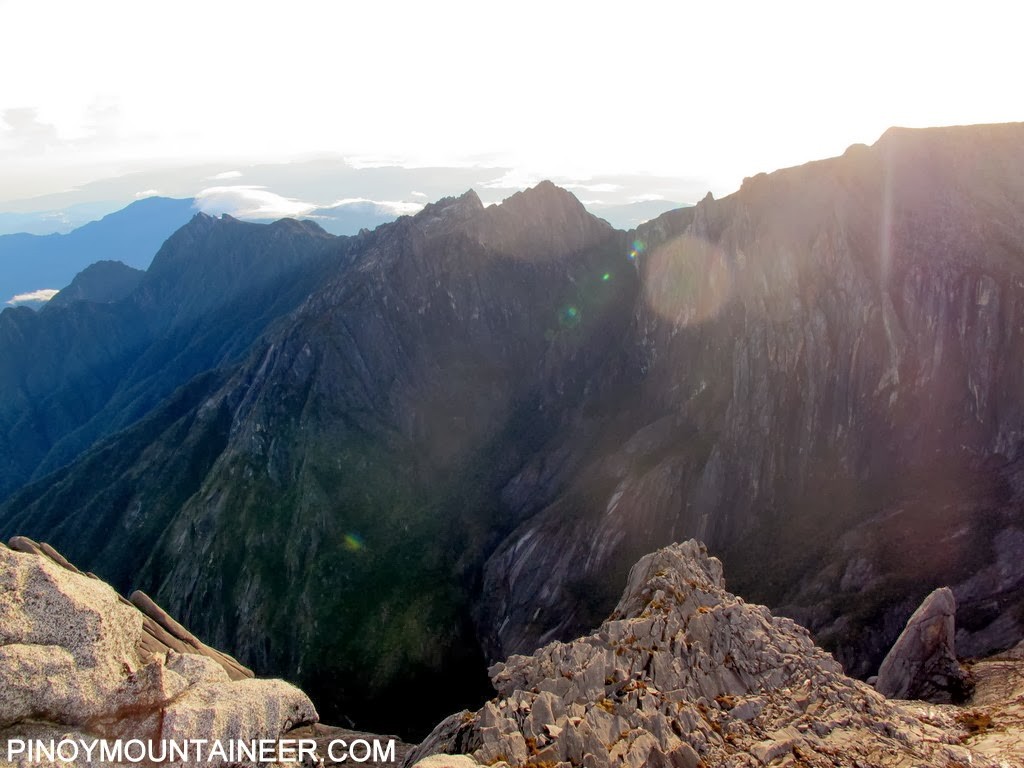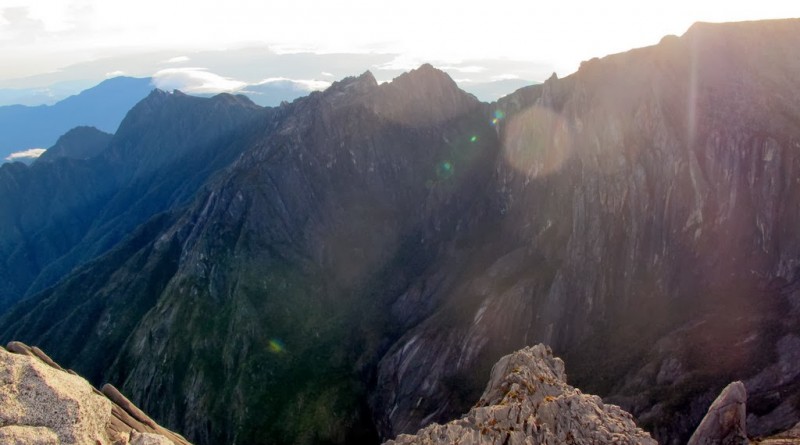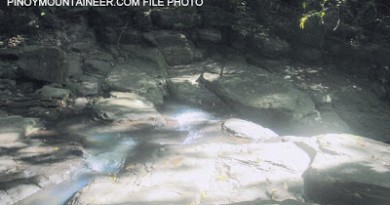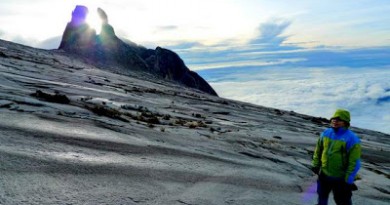Viewpoint: Hiking photography and a tragic death in Mt. Kinabalu
 |
| View of the steep face of Low’s Peak, where a German hiker fell to her death on February 10, 2014. |
by Gideon Lasco
PinoyMountaineer.com
It is always a sad thing whenever an accident happens in the outdoors, and I am very sorry to hear about the accident in Mt. Kinabalu two days ago when a 22-year old German hiker, Viktoria Paulsen, fell to her death from the summit. The manner of her death is troubling; according to the New Straits Times, “[S]he was taking photographs from around the peak of the mountain (Low’s Peak at 4,095m) when she slipped and fell.” Other reports mention that she went over the roped fence that was installed to protect hikers, presumably to get a better view.
The summit of Mt. Kinabalu usually gets crowded early in the morning because the hike is programmed in such a way that everyone starts from Laban Rata more or less at the same time (around 2:00-3:00 am), and many are eager to reach the summit to await the sunrise. But as a result of the ‘crowd’ at the top, it is difficult to get unobstructed shots, and oftentimes you only have a few seconds to pose at the summit. I can surmise that it is this situation that prodded Ms. Paulsen to go over the fence.
***
NOWADAYS, photography has become a crucial – even integral – part of our lives. Social media has allowed us to document and broadcast our everyday experiences by capturing them through photographs, and this idea of sharing has affected the way we go about our activities. A reunion or party with family or friends is not complete with the group shot at the end; and of course the photograph is not ‘fulfilled’ without its being posted, liked, commented on, and shared. People share photos of the things they buy, the people they meet, the places they see, and even the food they eat. The visual has replaced the verbal as the primary means of narrating our lives.
This has also been increasingly true of hiking: There are group shots, jump shots, macro shots (of the flora and fauna), summit photos, and of course, selfies. With so much beauty in the outdoors, the incitement towards photography is very understandable and justifiable.
When you are in the mountains, however, there are some things that are difficult to capture. Occasionally, a beautiful bird or insect would appear in front of you, then disappear before you can even get hold of your camera. Or, clouds would suddenly give way to an awesome view, only to obscure everything again, leaving a picture only in your mind. When you have just finished descending down a rock face and see your companion doing the same, you might think: “Wow, this would make a great action shot!” but when you snap your camera the image ends up blurred. And we say: “Sayang!“
Pangs of regret are always there, but sometimes we refuse to leave it at that. Many of us are tempted to intervene in order to make the picture better – even if it requires us to “rewind” our hike, climb up a tree, or go to a precarious rock formation. Hiking photography becomes problematic – and at times risky – when we refuse to settle for anything less than perfect view, or the perfect pose. One dramatic example: in 2012, a hiker in Alaska was killed by a grizzly bear when he got too close in his attempt to take photos of the animal.In two accidents in 2013 reminiscent of the one in Kinabalu, a hiker fell to his death while taking photos in a mountain viewpoint in the US, while a female hiker in Toronto was posing for a photograph when she fell off a cliff in Mount Nemo. Closer to home, in 2012, when first-time hiker Diana Fajardo fell to her death in Mt. Batulao, she was reported to have been taking pictures.
What can we learn from these tragedies?
First, I think that we should really be cautious with hiking photography, whether we are on the summit or on the trail; we should also inculcate this sense of caution to those who are novices. In the same way that texting while driving can lead to road accidents, photography while hiking can lead to outdoor mishaps, if the camera lens diverts our eyes to the more pressing things we need to see – like a protruding branch or a slippery stone. Even just holding your camera can be a liability, in situations when your hand can serve you best by being there for balance or protection. Taking photos (or posing) in precarious parts of the trail should be avoided, mindful that precarity is both absolute and relative: there are absolutely dangerous parts, and there are also parts that can be easy for experienced hikers but potentially dangerous for beginners.
Second, we should respect and follow rules. The existence of those roped fences are an explicit and obvious appeal to hikers not to trespass them, for their own safety. There are many reasons to be discontent or dissatisfied with the authorities but when people’s safety is at stake we should never second guess measures like “Do not enter” or “Do not pass”. They are there for a reason.
Finally (and more philosophically), I think we should re-examine the way we experience the outdoors in relation to our felt need of capturing and sharing each moment. It is very nice to let others know about the beauty and adventure we experience – I obviously do this a lot – but from time to time, we should seek to liberate ourselves from the need to share the moment, and instead allow ourselves the more introspective way of capturing the beauty and the experience of the outdoors: unaided by any instrument. Our eyes are still the best lenses through which we see the world. Any human being can attest that the best moments in our lives cannot be captured by the camera.
***
ONE mistake – even if it is a fatal mistake – should never be used to judge a person’s life and I write these thoughts with deep sympathy for Viktoria Paulsen’s family and friends. In a sense, her death is metaphorical of all forms of deaths in the outdoors: People go to the mountains to get a better, unobstructed view of the world, and in doing so, they make themselves vulnerable to what others might see as unnecessary risk – a risk that may translate to dire consequences. The consolation is that, whatever fate befell them, they were in pursuit of something they believed in, something they wanted to do.
Still, we should always try our best to make hiking as safe as possible. One day after the Mt. Kinabalu incident, the Sabah government spoke of plans to review park rules of regulations. Ultimately, however, we must also recognize the responsibility of individuals. We are all very familiar with the admonition to “take nothing but pictures.” But we must also remember that taking pictures is only secondary to taking care of one’s self.





Leave a Reply
3 Comments on "Viewpoint: Hiking photography and a tragic death in Mt. Kinabalu"
I also do amateur photography and just now i realized the risks i took at Maculot Rockies just for a good shot… Bottom line is knowing where to draw the line between personal safety and desire for photography…
this post is so timely and we need to share this to everyone who loves the outdoors. this is exactly what my thoughts were when my husband and i hiked up to maculot last month. the wind up in the rockies was so strong and treacherous. it can send you to your death when you pose at those precarious spots.
This is a really sad. I was a bit guilty of this when I tried to get close to the edge of the new Kanlaon crater. I didn't realize that the rocks were supposed to be the boundaries.
Yup, I agree with your call to cease victim-blaming. It tends to happen a lot during these cases.